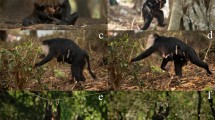Abstract
A common criticism of nestbox studies is one of creating artificial nesting conditions and breeding behavior different from what would be seen under natural conditions. We assessed the frequency of extra-pair paternity (percentage of broods with at least one extra-pair young) in 25 families of tree swallows (Tachycineta bicolor) nesting in natural cavities and compared it to that in a nestbox population. We found that 84% of females nesting in natural cavities obtained fertilizations from extra-pair males. These extra-pair males fathered 69% of all nestlings. Studies of tree swallows breeding in nestboxes have shown that 50–87% of broods contained extra-pair young, with extra-pair males fathering 38–53% of all the young. In broods with extra-pair paternity, natural cavities contained a significantly greater proportion of extra-pair young than did nestboxes. Despite differences in nesting habitat and female age structure, the frequency of extra-pair paternity did not differ significantly between the natural-cavity and nestbox populations. Therefore, the presence of extra-pair paternity in tree swallows is not an artifact of nestboxes or of artificial nesting conditions.
Similar content being viewed by others
Author information
Authors and Affiliations
Additional information
Received: 2 May 1995/Accepted after revision: 14 January 1996
Rights and permissions
About this article
Cite this article
Barber, C., Robertson, R. & Boag, P. The high frequency of extra-pair paternity in tree swallows is not an artifact of nestboxes. Behav Ecol Sociobiol 38, 425–430 (1996). https://doi.org/10.1007/s002650050260
Issue Date:
DOI: https://doi.org/10.1007/s002650050260




